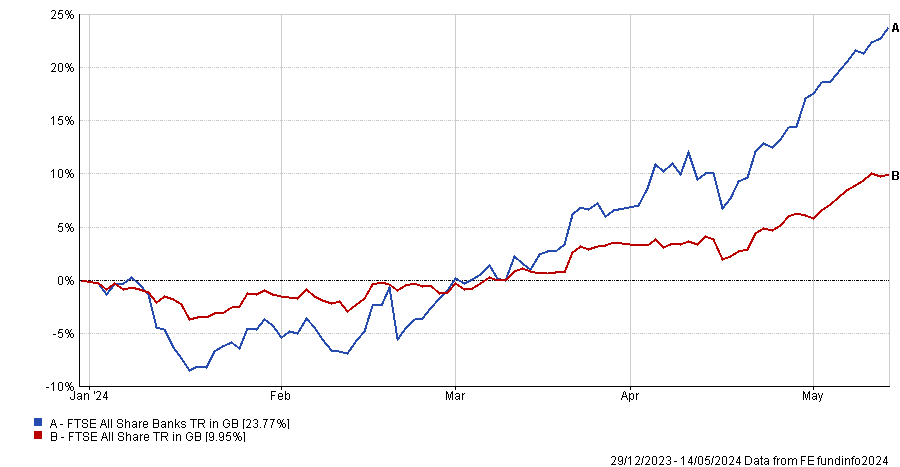UK banks have outperformed the wider market over the opening months of 2024 and analysts at investment platform Hargreaves Lansdown think there are compelling reasons for further gains.
The FTSE All Share Banks index has made a 23.8% total return over 2024 to date, more than double the gain in the FTSE All Share. This adds to a recent history of strength: while it took banks a long time to recover from the financial crisis, the FTSE All Share Banks index is up 69% over five years versus just 27.3% from the FTSE All Share.
Performance of UK banks vs wider market over 2024

Source: FE Analytics. Total return in sterling between 1 Jan and 14 May 2024.
Matt Britzman, equity analyst at Hargreaves Lansdown, said: “The UK’s largest banks have a spring in their step with first quarter results strong across the board and economic data points to clement conditions ahead.”
Below, the analyst gives four key takeaways from the recent UK bank reporting season.
Default levels remain low
Loan defaults – or the failure of borrowers to make required repayments on debt – are a key concern for banks and something that investors play close attention to.
However, Britzman pointed out that borrowers have shown “impressive resilience” over the past year despite rising costs and increasing interest rates, which often make it harder for people to pay back loans.
This does not mean that loan defaults are falling. A Bank of England survey of lenders found that default rates on loans to households and small- to medium-sized businesses increased in 2024’s first quarter and are expected to have risen again in the second quarter.
“Banks need to keep track of the money they might not get back from loans, and these expected losses show up as negative entries in their financial reports,” he added. “But first quarter results were strong: fewer people than expected are failing to pay back their loans, and the hit to profits was much smaller than many had feared.”
Higher for longer interest rates could act as a tailwind
Higher interest rates tend to benefit banks – so long as they do not cause a significant uptick in loan defaults. So, with borrowers being more resilient than feared, the prospect of interest rates staying higher for longer could be another positive for many banks.
Several months ago, some of the big banks thought interest rates would be cut several times in 2024, which would reduce the income they derived from loans. However, inflation is being more sticky than central banks had hoped so they are unlikely to cut rates as fast as many first thought they would.
“It’s still too early for banks to revise their income guidance, but if current trends continue, they may have the confidence to raise guidance in the coming quarters,” Britzman said.
The UK economic outlook is improving
Another reason for optimism in UK banks are signs of an improving domestic economy. Britzman said one of the key themes raised by bank management teams in reporting season’s investor calls was an improved outlook for the UK economy, albeit “from a low base”.
Given this, banks expect lending volumes to improve over the course of the year, the housing market to continue to show signs of improvement and wage growth to remain ahead of inflation.
Britzman added that domestic-focused banks like Lloyds and NatWest, which are seen as UK economic bellwethers, look best placed to benefit from this trend.
Capital levels support strong shareholder returns
The final positive sign for UK banks is that many are banks are sitting on strong capital levels, which the Hargreaves Lansdown analyst described as “one of the key strengths of this cycle”.
This is important for investors, as this capital allows banks to absorb shocks, acts as a foundation for growing the loan book and offers scope for shareholder returns.
Britzman concluded: “The potential for shareholder returns should be seen as a key attraction for the banking sector.
“A good run so far in 2024 means yields have come down a touch, but given the strong capital positions, investors can expect some hefty dividends and buybacks over the medium term.”





